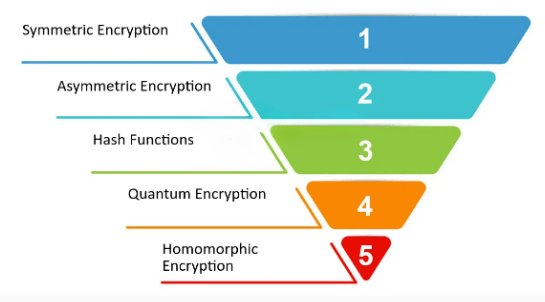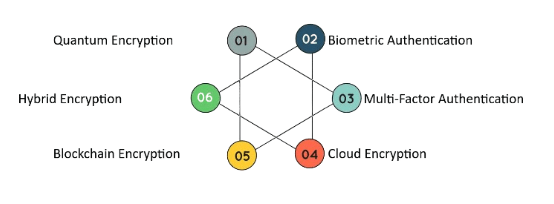
Data safety has been regarded as the most paramount in this cyber world, where today’s threats are becoming so sophisticated. Network security encryption is one of the means of achieving important data safety. Encryption is defined as encoding readable data to an unreadable format that only those in receipt of the proper decryption key are allowed to decode or decipher, a concept often covered in Cyber Security Training Courses to ensure a thorough understanding of data protection methods. Providing confidentiality, integrity, and authenticity of data as data traverses the network is the importance of Encryption. This paper will thus discuss the role of Encryption in Network Security, its workings, and the key reasons it forms an essential part of securing the integrity of the data on a network against malicious threats.
Ready to Earn Your Cyber Security Professional Certification? Discover the Cyber Security Online Training Now Available at ACTE!
What is Encryption?
Encryption is the process of converting readable plain text data into ciphertext and an unreadable format using an algorithm and an encryption key, while decryption means the reverse process; only the owner of the decryption key corresponding to it can reverse the Encryption and return the ciphertext into its plaintext. This means that Encryption helps protect sensitive data from unauthorized access, which is a crucial aspect of maintaining good Cyber Hygiene. There are other encryption algorithms besides symmetric Encryption, whereby a single key is used for Encryption and decryption. Asymmetric encryption works by having one pair of keys that enables Encryption using the public key and decryption results using the private key, all aiding in providing security on data at the transmission interface.
The Importance of Encryption in Network Security
Network security becomes more complicated when organizations increasingly depend on digital communication and cloud-based solutions. Such means of communication ensure that sensitive data remains safe from hackers, eavesdroppers, or other malicious elements as it passes through many insecure channels, including the Internet. It protects the network since the data is encrypted and protected from various risks. Then, Network Segmentation becomes very important since it divides parts of the network into unique sections or sub-networks to reduce the different impacts in case of a breach. The overall security can be improved by limiting access to sensitive information.
Some of these risks include:
- Data breaches: They defend against unauthorized access to sensitive data.
- Man-in-the-middle attacks: Intercepting is not done; data modification in transit is being done.
- Identity theft: is the misappropriation or theft of financial and personal data.
- Ransomware and malware: Encryption helps protect against unauthorized systems’ alterations or data extraction.
- Confidentiality: Only authorized persons or systems can read Encryption when data are encrypted. Encryption becomes effective in sensitive communication, such as email or financial transactions.
- Integrity: EncryptionEncryption helps maintain data integrity by preventing unauthorized changes during transmission. For example, a receiver can verify if the message was changed during transit by matching the decrypted message against a hash value.
- Authentication: The public key cryptosystem verifies who is at the end of the communication, thus preventing impersonation and other forms of fraud.
- Non-repudiation: It also ensures that the event of a transaction or communication took place. Often necessary for legal and business reasons.
- Performance Overhead: Latency is causing higher bounds on encrypting and decrypting large volumes of data. Potentially, it degrades application and network performance.
- Key Management: Primary management comprises encryption key management, which is more important to security. If the keys are lost or compromised, this may cause unauthorized access to sensitive data.
- Compatibility: There are differences in encryption standards and algorithms that only work with some systems or devices, creating integration issues.
- Legal and Compliance Issues: It will be restricted in some countries since it is forbidden. Several regulations exist; for example, encryption use has been regulated in certain countries.
- Use Strong Encryption Algorithms: Always use industry-standard encryption algorithms like AES-256 or RSA. Use DES or MD5, as it is outdated and weak.
- Implement End-to-End Encryption: For safe communication, data must be encrypted from sender to recipient, and no intermediate can decrypt it, a concept typically covered in Cyber Security Training Courses to ensure secure data transmission practices.
- Change encryption keys periodically: Change encryption keys regularly and store them safely. Implement a key management system to implement and manage the key lifecycle.
- Train Employees: Employees, especially those who handle encrypted information or manage encryption keys, should be trained in encryption Encryption’s requirements and how to apply them correctly, including proper management and safe storage of encryption keys.
- Monitor and Audit Network Traffic: Regularly monitor network traffic to detect potential vulnerabilities and ensure that encrypted data is not being tampered with or misused.
Get Your Cyber Security Certification by Learning from Industry-Leading Experts and Advancing Your Career with ACTE’s Cyber Security Online Training.
Investigating Different Encryption Techniques
The paramount question of private information security arises from this sea of continuous, never-ending information flows. Encryption methods may be termed virtual fortresses, protecting information from all-seeing cyber threats. In our exploration of encryption techniques, we will discuss different encryption methods with their unique approaches and strengths.
1. Symmetric Encryption
Symmetric Encryption Shared Secret The most ancient form of Encryption is symmetric and the least complex. Such a form of Encryption makes use of a secret key to both encrypt as well as decrypt. It compares to locking a door using a single key and later unlocking it using the same key. Symmetric Encryption is efficient and runs at very high speeds, but it has only a large amount of data. The problem remains with how the key can safely be shared between the parties to communicate. Other symmetric encryption algorithms include the Advanced Encryption Standard-AES and Data Encryption Standard-DES.

2. Asymmetric Encryption
Two Keys for a Secure Conversation Asymmetric Encryption- the other name for public-key cryptography- uses a pair of keys: the public key is used for encrypting the message, and the private key is applied to decrypt it. This new method solves the problem of distributing keys, which are used to plague symmetric Encryption. Users can distribute their public keys without restriction but must keep the decryption key secret, thereby having safe and secure communication without sharing it. Asymmetric Encryption is also known as a public encryption key.
3. Hash Functions
Input data of any length is mapped into a fixed-size output, a checksum or hash value, which acts as a digital fingerprint. Even minor changes to the input produce vastly different hash values, making them effective for data integrity checks. SHA-256 is a cryptographic hash function belonging to the SHA-2 family. Hash functions ensure secure storage and verification. Using Threat Intelligence with hashing, such as SHA-256, will allow organizations to discover emerging threats, safeguard data integrity, and protect from modification.
4. Quantum Encryption
Quantum mechanical power-based quantum encryption uses the principles of quantum mechanics to encrypt a given communication channel. Quantum key distribution guarantees that no party intercepts a given key being exchanged between the parties because the existence of an eavesdropper can easily be detected. Some of the most critical algorithms used in quantum Encryption are the BB84 protocols, which depend on the quantum properties of photons to establish a secret key between two parties. Quantum encryption promises ultrasecure communication, which is resistant to traditional attacks on cryptography.
5. Homomorphic Encryption
Operations on Computed Data on Encrypted Contents Homomorphic Encryption is the computation of encrypted data and processing without decrypting in advance. It ensures the secure processing of data within the cloud, allowing service providers to make computations directly on encrypted data without observing its contents. It provides data privacy while permitting outsourced computation. Microsoft SEAL is one of the libraries that implement homomorphic Encryption, op, opening doors, for secure data analysis and computation.
How Encryption Protects Network Data
Network security includes Encryption, which protects against unauthorized access. Any data taken during the route is unreadable. Encryption guards the information toward confidentiality, integrity, and authenticity. Whether it has to do with finance, personal, or corporate issues, Encryption works. Encryption is also protection against Malware Attack that stop malware from accessing and manipulating sensitive data.
Challenges in Implementing EncrEncryption
Encryption can go a long way in securing network data; challenges such as the following have to be encountered in implementing this method:
Want to Master Cyber Security? Explore the Cyber Security Expert Masters Program Training Course Offered at ACTE Today!
Best Practices for Using Encryption in Network Security
Best practices in terms of making Encryption in Network Security more effective include the following, which an organization can adopt:
Future Trends in Encryption
With increasing usage in transmitting and storing sensitive information, the need for enhanced data encryption is becoming more urgent. In contrast, with technological progress, cybercriminals continually expand their ways of entry into data meant to be protected. This makes data encryption critical in the future. Enumeration in Ethical Hacking plays a significant role here, as it serves as one of the tools for security professionals to identify potential vulnerabilities before they are used.
1. Quantum Encryption
Quantum encryption is one of the most promising breakthroughs in data encryption data encryption. Like quantum mechanics, quantum encryption functions based on the principles of quantum mechanics and depends on mathematical codes instead of algorithms based on mathematics. It is still in its nascent stages but can revolutionize data security as soon as it matures.
2. Biometric Authentication
Biometric authentication is the latest craze in data encryption. It is mainly based on a unique physical characteristic, like fingerprints or an individual’s face. This method is more effective than the traditional password-based method, which is easily hacked.

3. Multi-factor authentication
Multi-factor authentication protects people’s data more. Users must provide multiple types of authentication, such as a password, security token, and biometric data, before access to information is granted; hackers find it much harder to get this information.
4. Cloud Encryption
Cloud encryption has emerged as a new icon of data security in cloud computing. This implies encrypting the data before uploading it into the cloud so that even if the provider is hacked, it does not expose any data. Good Cyber Hygiene, such as updating the software and using strong password encryption, protects sensitive data Encryption. All these give way to common risk-mitigating practices that result in more protected digital environments for individuals and organizations.
5. Blockchain encryption
Possibly the new name for data encryption, blockchain technology seems to have garnered much attention lately. It is also used for encrypting data. It includes creating a decentralized database that can’t easily be hacked. This technology is here to revolutionize data security in many industries.
6. Hybrid Encryption
Each of the above is very strong in its own right, but many solutions exist for encrypting data. Hybrid Encryption uses one or more forms of encryption methods in combination. For instance, a corporation could use encryption Encryption for its most sensitive information, biometric authentication for the rest, and multi-factor authentication for the rest.
All Set for an Cyber Security Job Interview? Take a Look at Our Thorough Collection of Cyber Security Interview Questions and Answers to Help You Prepare!
Conclusion
Encryption is essential to Network Security because it protects network data from aggressive hackers. Data encryption offers privacy, integrity, and authenticity as mechanisms of protecting data to lower hackers’ risks significantly, data breach risks, or unauthorized access to any business’s information. Though not easy to implement due to challenges with key management and performance overhead, the importance of encrypting sensitive data must be balanced, a critical topic often explored in Cyber Security Training Courses to help professionals navigate these challenges effectively. Encryption in Network Security is essential for maintaining the privacy and trustworthiness of communications and protecting organizational assets from malicious threats. As technology advances, so will the security of data encryption as a key part of network security, in terms of new challenges and emerging threats.





